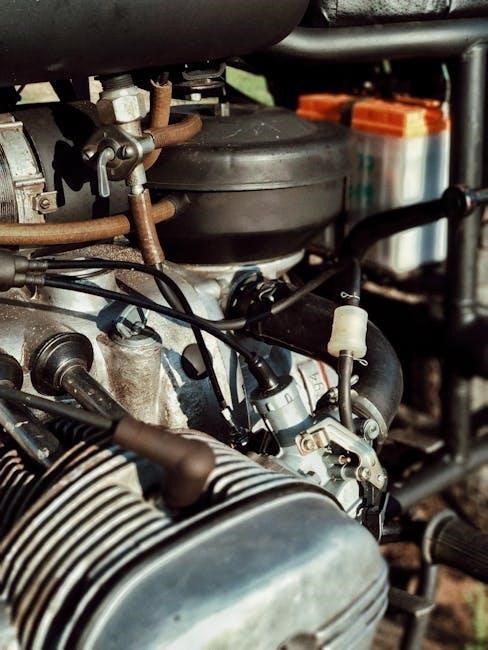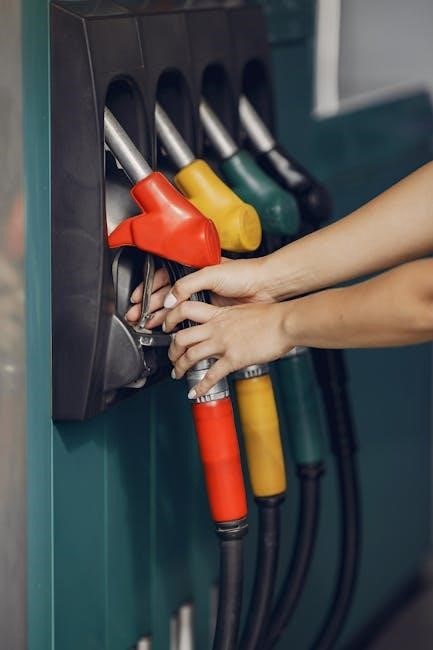Power Pressure Cooker Manual: A Comprehensive Guide
Welcome! This comprehensive guide is designed to help you master your Power Pressure Cooker. From initial setup to advanced techniques, we’ll cover everything you need to know for safe and efficient use, ensuring delicious meals every time.
Understanding the Power Pressure Cooker
The Power Pressure Cooker is an electric appliance designed for efficient and convenient cooking. It works by creating a sealed environment where steam pressure builds up, leading to higher cooking temperatures and faster cooking times compared to traditional methods. This process not only speeds up meal preparation but also helps to retain more nutrients in your food. The cooker is equipped with various safety features such as pressure sensors, automatic pressure control, and electrical fuse to ensure safe operation. Understanding how these components work together is crucial for using the pressure cooker effectively. Familiarize yourself with the different settings and functions, including the pressure cooking modes, which require the addition of liquid in some form (water, stock, etc.). Always follow recipes carefully for liquid addition suggestions, especially if you are new to pressure cooking. The Power Pressure Cooker XL is designed to provide years of delicious family meals. Before you begin, it’s important to read the entire manual to fully understand its operation and safety precautions. This includes knowing how to properly close the lid, set the pressure valve, and release pressure safely after cooking. Avoid forcing the cooker open; always release the pressure first using the KEEP WARM/CANCEL button and carefully rotating the Pressure Valve to the OPEN position. Make sure all steam has dissipated before opening. By understanding these basics, you can confidently and safely use your Power Pressure Cooker XL for a variety of recipes.

Key Features and Components
The Power Pressure Cooker boasts several key features and components that contribute to its efficient and safe operation. These include the Inner Pot, typically made of non-stick material for easy cleaning and even heat distribution. The Lid, designed to create an airtight seal, is crucial for building pressure inside the cooker. It includes a Rubber Gasket that ensures the seal is tight and prevents steam from escaping during cooking. The Pressure Valve is another essential component, used to regulate and release pressure. It can be toggled between the CLOSE position for pressure cooking and the OPEN position for releasing pressure. The Control Panel allows you to select different cooking modes and set the cooking time. It features an LED display that shows the remaining cooking time and other important information. The Automatic Pressure Control maintains working pressure levels and suspends heating if pressure exceeds safety limits. An Electrical Fuse cuts off power if the electrical current exceeds safety limits, preventing potential hazards. The Power Cord connects the cooker to a power outlet. Ensure it is securely plugged in before use. Some models may include additional accessories such as a 3-Layer Wire Rack for poaching, steaming, or cooking different foods simultaneously. Understanding these features and components is vital for operating the Power Pressure Cooker safely and effectively. Always refer to the manual for specific details about your model.
Initial Setup and Preparation
Before using your Power Pressure Cooker for the first time, proper initial setup and preparation are crucial for ensuring safe and optimal performance. First, carefully unpack all components and ensure that you have all the necessary parts, including the inner pot, lid, rubber gasket, pressure valve, and power cord. Thoroughly wash the inner pot, lid, and rubber gasket with warm, soapy water. Rinse them with clean water and dry completely. This step removes any manufacturing residue and ensures hygiene. Inspect the rubber gasket for any signs of damage or wear. Ensure it is properly seated inside the lid, creating a tight seal. Place the inner pot inside the cooker unit, ensuring it sits securely on the heating element. Connect the power cord to the pressure cooker and then plug it into a wall outlet. The LED display should light up, indicating that the cooker is receiving power. Familiarize yourself with the control panel and its various functions, such as the cooking modes and timer settings. Before your first cooking session, perform a water test to ensure the cooker is functioning correctly. Add about 2 cups of water to the inner pot, close the lid securely, and set the pressure valve to the CLOSE position. Select the appropriate cooking mode (e.g., Steam) and set the timer for a short duration (e.g., 5 minutes). Observe the cooker as it builds pressure and releases steam. Once the cooking cycle is complete, allow the pressure to release naturally or manually release it by carefully turning the pressure valve to the OPEN position. After the water test, your Power Pressure Cooker is ready for use. Always refer to the manual for specific instructions and safety precautions related to your model.
Operating Instructions: A Step-by-Step Guide
Operating your Power Pressure Cooker is straightforward once you understand the basic steps. This guide provides a clear, step-by-step approach to ensure safe and successful cooking. Begin by placing the inner pot into the cooker unit, making sure it sits securely on the heating element. Add your ingredients to the inner pot, following your recipe’s instructions for the correct amount of liquid. Never fill the pot beyond the maximum fill line, as this can cause pressure issues and potential hazards. Secure the lid by aligning the handle and recessed valve to the 1:00 o’clock position, then rotate the lid counter-clockwise until you hear a click; This ensures the lid is properly sealed. Toggle the pressure valve switch to the CLOSE position to prevent steam from escaping during the cooking process. Select the appropriate cooking mode from the control panel, such as “Meat/Poultry,” “Beans/Lentils,” or “Rice/Risotto,” depending on your recipe. Use the cook time selector to adjust the cooking time according to your recipe’s instructions. Press the “Start” button to begin the cooking cycle. The cooker will start building pressure, which may take a few minutes. Once the pressure is reached, the timer will begin counting down. After the cooking cycle is complete, the cooker will switch to the “Keep Warm” mode automatically. You can either allow the pressure to release naturally, which may take 10-20 minutes, or manually release the pressure by carefully turning the pressure valve to the OPEN position using tongs or a kitchen tool. Be cautious of the hot steam that will be released. Once all the pressure is released and the float valve drops, you can safely open the lid. Carefully remove the lid, tilting it away from you to avoid any residual steam. Serve your meal and enjoy! Always refer to your specific model’s manual for detailed instructions and safety guidelines.
Safety Precautions and Guidelines

Safety is paramount when operating any pressure cooker, and the Power Pressure Cooker is no exception. Adhering to these precautions and guidelines will ensure safe and reliable use. Before each use, inspect the cooker for any signs of damage, such as cracks in the inner pot or a worn-out sealing ring. Never use the cooker if any parts are damaged. Ensure the sealing ring is properly installed in the lid before each use. A properly seated sealing ring is crucial for maintaining pressure and preventing steam leaks. Never force open the lid while the cooker is under pressure. Always release the pressure completely, either naturally or manually, before attempting to open the lid. Use tongs or a kitchen tool to carefully rotate the pressure valve to the OPEN position when manually releasing pressure, and keep your hands and face away from the steam vent to avoid burns. Do not overfill the inner pot. Always stay below the maximum fill line, especially when cooking foods that expand, such as rice or beans. Overfilling can cause the pressure valve to clog and create a hazardous situation. Never immerse the cooker base in water or any other liquid. The base contains electrical components that can be damaged by water. Clean the cooker base with a damp cloth only. Keep the pressure valve and steam release pipe clean and free from obstructions. A clogged valve can cause excessive pressure build-up. Always unplug the cooker when not in use and before cleaning. This prevents accidental activation and potential electrical shock. Supervise children closely when the pressure cooker is in use. The cooker gets hot during operation and can cause burns. Do not move the cooker while it is under pressure or contains hot liquids. Wait until the cooker has cooled down and the pressure has been released before moving it. Always use caution when handling hot food and liquids from the cooker. Use oven mitts or pot holders to protect your hands from burns. By following these safety precautions and guidelines, you can enjoy the convenience and benefits of your Power Pressure Cooker while minimizing the risk of accidents.

Troubleshooting Common Issues
Even with careful use, you might encounter occasional issues with your Power Pressure Cooker. Here’s a guide to troubleshooting common problems: If the cooker doesn’t power on, first ensure that the power cord is securely plugged into both the cooker and the wall outlet. Check the outlet to confirm it’s working by plugging in another appliance. If the cooker still doesn’t turn on, the electrical fuse may have blown. Refer to the manual for instructions on how to replace the fuse, or contact customer support. If the cooker fails to reach pressure, ensure the sealing ring is properly installed and the lid is securely locked. Check the pressure valve to make sure it’s in the CLOSED position. If steam is leaking from around the lid, the sealing ring may be damaged or not properly seated. Inspect the ring for cracks or tears and replace it if necessary. Make sure the ring is clean and properly positioned in the lid. If the food is undercooked, ensure you’re using the correct cooking time and pressure setting for the type of food you’re preparing. Add more liquid if necessary, as insufficient liquid can prevent the cooker from reaching pressure. If the food is overcooked, reduce the cooking time or pressure setting. Consider using the KEEP WARM function to maintain the food’s temperature without further cooking. If the cooker displays an error code, consult the manual for the specific meaning of the code and recommended solutions. Common error codes may indicate issues with pressure, temperature, or sensor malfunctions. If the pressure valve is clogged, carefully clean it with a small brush or pin. Ensure all food particles are removed to allow for proper steam release. If you experience excessive steam release during cooking, reduce the amount of liquid in the pot or adjust the pressure setting. Ensure the pressure valve is securely closed. If the inner pot is difficult to remove, allow the cooker to cool completely before attempting to remove it. Use oven mitts or pot holders to protect your hands from burns. If you’re unable to resolve the issue using these troubleshooting steps, contact customer support for further assistance. Provide them with the model number and a detailed description of the problem.

Cleaning and Maintenance Tips
Proper cleaning and maintenance are essential for ensuring the longevity and performance of your Power Pressure Cooker. Always unplug the cooker and allow it to cool completely before cleaning. The inner pot, lid, and sealing ring should be washed after each use with warm, soapy water. Use a non-abrasive sponge or cloth to avoid scratching the inner pot. The inner pot and lid are typically dishwasher-safe, but check your specific model’s manual for confirmation. The sealing ring should be removed from the lid and washed separately. Inspect it for cracks or damage and replace it if necessary. The sealing ring can absorb odors, so consider soaking it in a solution of water and vinegar or baking soda to remove any lingering smells. Wipe the exterior of the cooker with a damp cloth. Avoid immersing the cooker base in water or any other liquid, as this can damage the electrical components. Clean the pressure release valve regularly to prevent clogging. Remove the valve and wash it with warm, soapy water. Use a small brush or pin to clear any food particles or debris. Check the anti-block shield on the underside of the lid and clean it as needed. This shield prevents food particles from blocking the steam release valve. Inspect the heating plate inside the cooker base for any food residue. Wipe it clean with a damp cloth. Avoid using abrasive cleaners or scouring pads, as they can damage the surface. Store the Power Pressure Cooker in a cool, dry place. Ensure all parts are completely dry before storing to prevent mold or mildew growth. When storing the lid, place it upside down on the cooker base to allow air circulation. This helps prevent odors from developing. Regularly check the power cord for any signs of damage. If the cord is frayed or damaged, do not use the cooker and contact customer support for a replacement. If you notice any unusual noises or malfunctions, discontinue use and contact customer support for assistance. Do not attempt to repair the cooker yourself, as this can void the warranty and pose a safety risk. By following these cleaning and maintenance tips, you can keep your Power Pressure Cooker in excellent condition and enjoy its benefits for years to come.
Pressure Canning with Power Pressure Cooker XL
Pressure canning with the Power Pressure Cooker XL requires careful adherence to safety guidelines to prevent the risk of botulism and ensure food safety. It is crucial to understand that not all pressure cookers are suitable for pressure canning, and it is essential to verify that your Power Pressure Cooker XL model is specifically designed and approved for this purpose. Always consult your cooker’s manual for specific instructions and safety precautions related to pressure canning. Before starting, ensure that you are using tested and approved recipes from reputable sources such as the USDA Complete Guide to Home Canning or university extension services. These recipes provide precise processing times and pressures for different types of foods. Use only jars and lids specifically designed for canning. Inspect jars for any cracks or chips and discard any damaged jars. Wash jars, lids, and bands in hot, soapy water and rinse thoroughly. Pre-heating the jars is recommended to prevent breakage during the canning process. Follow the recipe instructions for preparing the food to be canned. Pack the food into the jars, leaving the specified headspace. Remove any air bubbles by gently tapping the jars or using a non-metallic spatula. Wipe the jar rims clean with a damp cloth and place the lids on the jars, securing them with the bands. Do not overtighten the bands. Place the jars in the Power Pressure Cooker XL, ensuring they are arranged in a single layer. Add the amount of water specified in the recipe. The water level should be high enough to cover the jars partially, but not so high that it interferes with the pressure release valve. Secure the lid of the pressure cooker and follow the manufacturer’s instructions for setting the pressure and processing time. Monitor the pressure gauge or display throughout the canning process to ensure that the pressure remains consistent. After the processing time is complete, allow the pressure to release naturally. Do not attempt to force the pressure release, as this can cause the jars to explode. Once the pressure has completely released, carefully remove the jars from the cooker using a jar lifter. Place the jars on a towel-lined surface and allow them to cool completely. As the jars cool, you should hear a popping sound as the lids seal. After the jars have cooled, check the seals by pressing down on the center of each lid. If the lid flexes or pops back up, the jar is not properly sealed and should be reprocessed or refrigerated. Label and store the sealed jars in a cool, dark, and dry place. Properly canned foods can be stored for up to a year. Always inspect the contents of the jars before consumption. If there are any signs of spoilage, such as bulging lids, unusual odors, or cloudy liquid, discard the contents. Remember, pressure canning is a precise process that requires careful attention to detail. Always follow tested recipes and safety guidelines to ensure the safety of your canned foods.
Available Manuals and Resources
To ensure you have the best possible experience with your Power Pressure Cooker XL, a variety of manuals and resources are available to assist you. The primary resource is the owner’s manual that came with your specific model. This manual contains crucial information regarding the operation, safety precautions, and maintenance of your appliance. It is essential to read this manual thoroughly before using the Power Pressure Cooker XL for the first time. In addition to the printed manual, many digital versions are available online. These can be easily accessed and downloaded from the manufacturer’s website or various online retailers. Digital manuals offer the convenience of being accessible on your computer, tablet, or smartphone, making it easy to reference them while cooking. Several third-party websites and online communities dedicated to pressure cooking also provide valuable resources. These platforms often feature user forums, recipe databases, and troubleshooting guides. Engaging with these communities can provide additional insights and support from experienced users. Furthermore, many cooking blogs and websites offer recipes specifically tailored for the Power Pressure Cooker XL. These recipes often include step-by-step instructions, photos, and videos to guide you through the cooking process. Searching for recipes online can inspire you to try new dishes and expand your culinary repertoire; For visual learners, video tutorials are readily available on platforms like YouTube. These videos demonstrate various aspects of using the Power Pressure Cooker XL, from basic operation to advanced cooking techniques. Watching these tutorials can be particularly helpful for understanding complex procedures or troubleshooting common issues. If you encounter any problems with your Power Pressure Cooker XL, the manufacturer’s customer support is an invaluable resource. Contacting customer support can provide you with expert assistance and solutions to your specific concerns. They can also provide information about warranty coverage and repair services. Remember to have your model number and purchase date ready when contacting customer support. By utilizing these available manuals and resources, you can confidently operate your Power Pressure Cooker XL and enjoy delicious, home-cooked meals with ease. Whether you’re a beginner or an experienced cook, these resources offer valuable information and support to enhance your pressure cooking journey.
